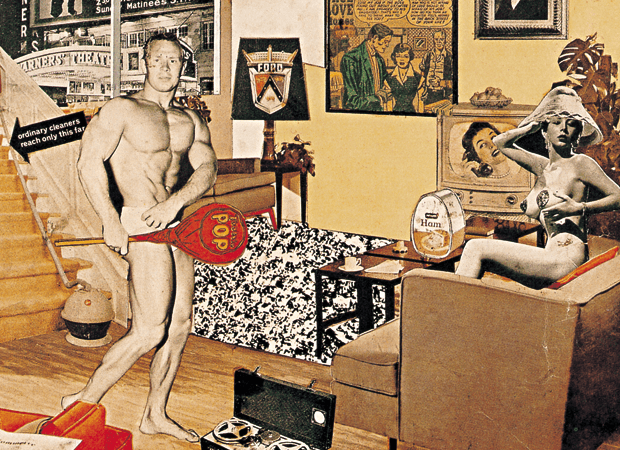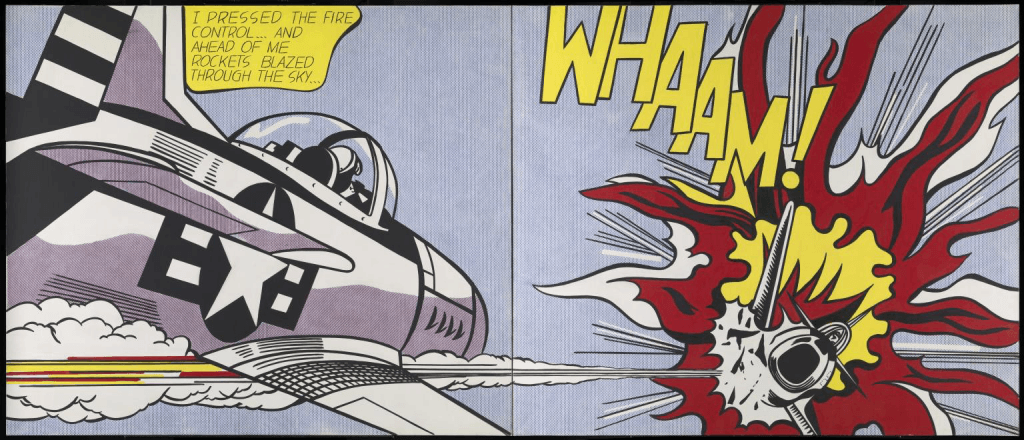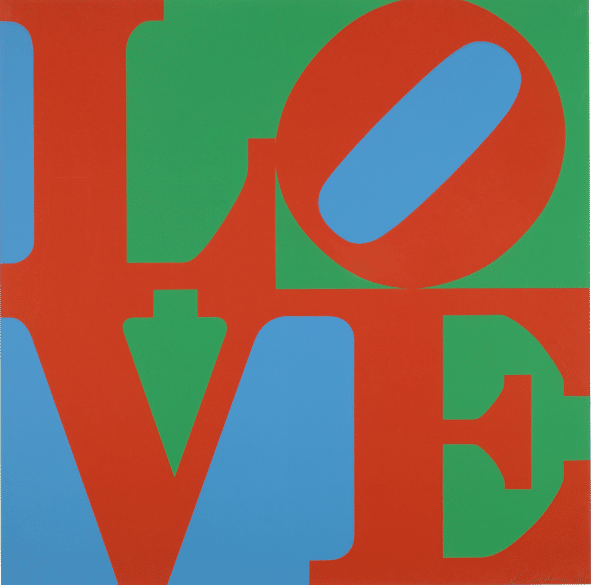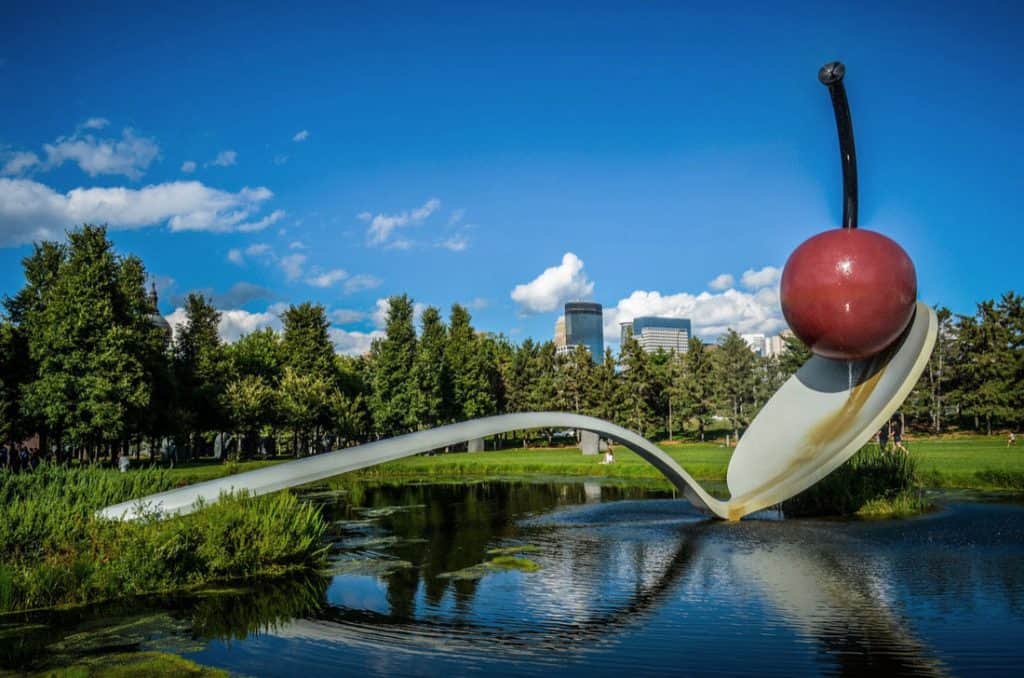Art Movement: Pop Art

“The Pop artists did images that anybody walking down Broadway could recognize in a split second – comics, picnic tables, men’s trousers, celebrities, shower curtains, refrigerators, Coke bottles – all the great modern things that the Abstract Expressionists tried so hard not to notice at all.”
Andy Warhol
The first definition of Pop Art was provided by British curator Lawrence Alloway, who invented the term ‘Pop Art’ in 1955 to describe a new form of art characterized by the imagery of consumerism, new media, and mass reproduction. Through bold, simple, everyday imagery, and vibrant block colors, Pop Art was one of the first art movements to narrow the divide between commercial and fine arts.
Pop Art artists took inspiration from advertising, pulp magazines, billboards, movies, television, comic strips, and shop windows for their humorous, witty and ironic works, which both can be seen as a celebration and a critique of popular culture.
Watch our video overview of the movement and read on to learn more about how did Pop Art emerge, who were the key pop artists, and what were their artistic aims and most iconic works.
Key dates: 1955-1965
Key regions: Britain and the USA
Key words: Popular culture, mass media, consumerism
Key artists: Andy Warhol, Roy Lochtenstein, Robert Rauschenberg, Claes Oldenburg, Richard Hamilton, David Hockney

Origins of Pop Art
Although generally associated with the United States, Pop Art found an early voice in Britain as a critical and ironic reflection on the post-War consumer culture of the late 1950s.
In 1952 Britain, in fact, a group of artists, writers, and critics which would come to be known as ‘Independent Group’ – or simply ‘IG’ – began to meet regularly, driven by a common perception of a gap between the art and life of the time to discuss new theories and methods to incorporate in the artistic practice those aspects of visual culture that weren’t traditionally part of it but that had inevitably become elements of the everyday life, from product packaging to cinema celebrities.
The group’s collective exhibition This Is Tomorrow, held at the Whitechapel Gallery in London in 1956, served as the key starting point for Pop Art, providing an unprecedented example of integration between art and modern life.
Overseas, in those same years, Pop Art emerged as a reaction against the dominant artistic movement, Abstract Expressionism. Buckling the idea that art is the individual expression of an artist’s genius, Pop Art allowed artists to reintroduce fragments of reality into art through images and combinations of everyday objects.
Jasper Johns and Robert Rauschenberg were among the first artists in America to capture the power of the ordinary, kick-starting the movement. The former explored the boundaries between art and the everyday world literally incorporating commonplace objects into painted canvas surfaces; the latter represented what he defined as “things the mind already knows”, a selection of recurring concepts and popular imagery.
Key ideas behind Pop Art
It was English Pop Artist Richard Hamilton who, in 1957, listed the characteristics of Pop Art, “Pop Art is: Popular (designed for a mass audience), Transient (short-term solution), Expendable (easily forgotten), Low cost, Mass produced, Young (aimed at youth), Witty, Sexy, Gimmicky, Glamorous, Big business.”
Pop Art made of the aesthetic of the banal its signature, mirroring the times of mass-production and quick, banal entertainment, while also investigating the commodification of fame. Everyday objects like Campbell’s soup cans and pop culture celebrities like Marilyn Monroe were transformed into art and became icons of the movement.
The elements of multiplicity and reproduction – typical of mass-production culture – also reflected in artistic media and processes: while acrylic paints allowed artists to create vivid, flat surfaces, the screen-printing technique produced boldly colored images as repeated patterns subverting the idea of painting as a medium of originality.
British Pop Art v.s. American Pop Art
Although British Pop Art was greatly inspired by American popular culture, it was a rather playful and ironic exploration of what American popular imagery represented and how it manipulated people’s lives and lifestyles.
To American artists, on the other hand, Pop Art meant a return to representation: hard edges, clear forms, and recognizable subject matter now reigned, contrasting with the loose abstraction and symbolism of the Abstract Expressionists.
Heavily influenced by commercial art practice, these artists were taking inspiration from what they saw and experienced directly. Not surprisingly, many had started their careers in commercial art. Andy Warhol was a magazine illustrator and graphic designer, Ed Ruscha was a graphic designer, and James Rosenquist started out as a billboard painter. Their backgrounds provided them with an excellent visual vocabulary of mass culture as well as the technical skills to jump effortlessly between high art and popular culture and to merge the two worlds.
Famous Pop Art artists
Leading British Pop Art artists included Sir Peter Blake (b. 1932), Patrick Caulfield (1936-2006), Richard Hamilton (b. 1922), David Hockney (b. 1937), and Allen Jones (b. 1937).
In American art, famous exponents of Pop Art included Robert Rauschenberg (1925-2008), Jasper Johns (b. 1930), Roy Lichtenstein (1923-97), and Andy Warhol (1928-87). Other American exponents included Jim Dine (b. 1935), Robert Indiana (aka John Clark) (b. 1928), Ray Johnson (1927-95), Alex Katz (b. 1927), Claes Oldenburg (b. 1929), Ed Ruscha (b. 1937), James Rosenquist (b. 1933-2017), and Tom Wesselmann (b. 1931).
Iconic works of Pop Art
Richard Hamilton, Just What Is It That Makes Today’s Homes So Different, So Appealing?, 1956

Richard Hamilton’s collage presents a living room space filled with objects and ideas that, according to Hamilton, were crowding into the post-war consciousness. Drawing the viewer’s attention is the figure of a bodybuilder holding a giant lollipop with the word ‘POP’ scrawled on it. Not surprisingly, then, this collage is often referred to as the first example of Pop Art.
Andy Warhol, Marilyn Diptych, 1962

Warhol’s fascination with popular culture and fame led him to produce a great number of screen-prints depicting portraits of celebrities, experimenting with variations in colors and multiplication.
His Marilyn Diptych contains 50 images of Marilyn Monroe, half of which are painted in color, the other half in black-and-white. The work was completed in the weeks following the actress’s death.
Roy Lichtenstein, Whaam!, 1963

Roy Lichtenstein’s Whaam! is a large, two-canvas painting composed like a comic book strip of a rocket explosion in the sky. Lichtenstein was interested in portraying highly charged situations in this particularly detached, calculated manner.
Keith Haring, Radiant Baby, 1982

In 1980s New York, Keith Haring turned the subway into his studio. Using chalk, he etched his signature designs onto the walls. One of these was his Radiant Baby, which to him was one of the purest and most positive human experiences. It became a recurring visual idiom of Haring’s throughout the years and is now considered the artist’s signature tag.
Robert Indiana, LOVE, 1967

Born Robert Clark in Indiana, Robert Indiana took his native state’s name when he moved to New York in 1954. This type of Pop-inspired fascination for the power of ordinary words was never more clear than in his LOVE artworks. Indiana’s LOVE is one of the most well-known images of Pop Art. It was originally conceived as a Christmas card for The Museum of Modern Art in 1965. Since then, LOVE has taken the shape of prints, paintings, sculptures, banners, rings, tapestries, and stamps.
Reception by the critics versus the public
While many academics and critics were appalled by the pop artists’ use of mundane subject matter and by their apparently indiscriminate employment of it, Pop Art’s more figurative and down-to-earth imagery appealed to the general public and would soon become one of the most popular styles of art as well as one of the first manifestations of postmodernism.
Collecting Pop Art
Pop Art succeeded in getting through to the general public in a way that few modern art movements did – or have done since – and art collectors like it, too. For example, the painting “False Start” (1959) By Jasper Johns sold in 2006, for $80 million: the 9th most expensive work of art in history at that time. The work “Green Car Crash” (1963) (synthetic polymer, silkscreen ink, and acrylic on linen) by Andy Warhol sold at Christie’s, New York, in 2007, for $71.7 million, making it the 14th highest-priced work of art ever sold at that time. Not bad for a work of low-brow art.

Written by Shira Wolfe
Relevant sources to learn more
Read more about Art Movements and Styles Throughout History


